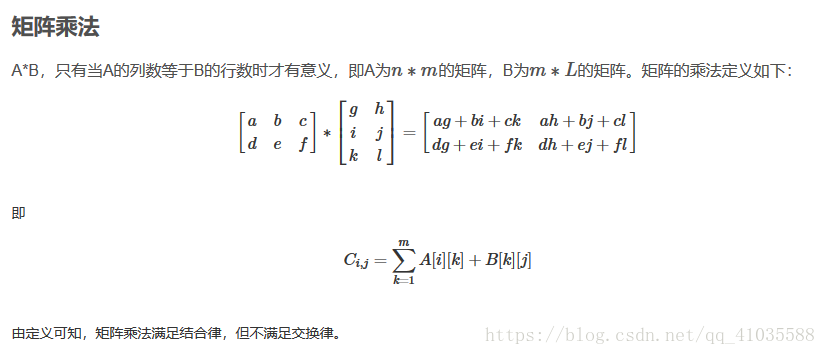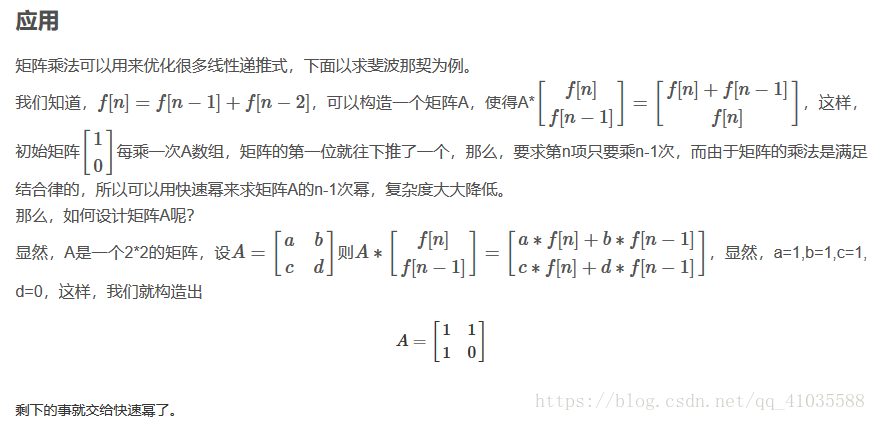
菲波那切数列在一些场景中很有用. 相信如何计算第n个斐波那契数是一些人接触到的第一个递归算法(尽管他的效率很低). 本篇讲述了如何一步步优化计算fib(n)
本文内容包括:
源代码: https://github.com/JasonkayZK/Java_Algorithm/tree/master/src/main/java/algorithm/basic
本文部分内容转自: 斐波那契数列 --- 四层优化
如果觉得文章写的不错, 可以关注微信公众号: Coder张小凯
内容和博客同步更新~
<br/>
<!--more-->数学函数定义:
fib(0) = 0, fib(1) = 1;
fib(n) = fib(n - 2) + fib(n - 1) [n > 1]
/**
* 斐波那契数列生成算法
*/
public class Fibonacci {
/**
* 递归计算生成fib(n)
*
* 时间复杂度: O(N^2)
*
* 空间复杂度:O(N)
*/
public static long fibRecursively(int n) {
return n < 2 ? Math.max(0, n) : fibRecursively(n - 1) + fibRecursively(n - 2);
}
}
/**
* 循环计算fib(n)
*
* 时间复杂度:O(N)
*
* 空间复杂度:O(1)
*/
public static long fibByArray(int n) {
if (n <= 2) return Math.max(0, n);
long fibOne = 1, fibTwo = 0, fibN = 0;
for (int i = 1; i < n; i++) {
fibN = fibOne + fibTwo;
fibTwo = fibOne;
fibOne = fibN;
}
return fibN;
}
斐波那契的通项公式为: fib(n) = 1/sqrt(5) * (((1+sqrt(5)) / 2) ^ n - ((1-sqrt(5)) / 2) ^ n
所以有:
/**
* 通过公式计算fib(n)
*
* 时间复杂度:O(logN)
*
* 空间复杂度:O(1)
*
*/
public static long fibByFormula(int n) {
return (long) ((Math.pow((1 + Math.sqrt(5)) / 2, n) - Math.pow((1 - Math.sqrt(5)) / 2, n)) / Math.sqrt(5));
}
算法原理:


总结成一句话就是, 可以将求解变为类似于生成快速幂的形式
代码如下:
/**
* 矩阵乘法实现(单线程最优解)
*
* @param n 计算fib(n)
* @return fib(n)
*/
public static long fibByMatrix(int n) {
if (n <= 2) return Math.max(0, n);
FibMatrix fibMatrix = FibMatrix.power(n - 1);
return fibMatrix.m00;
}
/**
* fibByMatrix计算使用到的2x2的矩阵
*/
private static class FibMatrix {
private long m00;
private long m01;
private long m10;
private long m11;
public FibMatrix(long m00, long m01, long m10, long m11) {
this.m00 = m00;
this.m01 = m01;
this.m10 = m10;
this.m11 = m11;
}
/**
* 定义2×2矩阵的乘法运算
*
* @param matrix1 matrix1
* @param matrix2 matrix2
* @return 矩阵乘法结果
*/
public static FibMatrix multiply(FibMatrix matrix1, FibMatrix matrix2) {
FibMatrix matrix12 = new FibMatrix(1, 1, 1, 0);
matrix12.m00 = matrix1.m00 * matrix2.m00 + matrix1.m01 * matrix2.m10;
matrix12.m01 = matrix1.m00 * matrix2.m01 + matrix1.m01 * matrix2.m11;
matrix12.m10 = matrix1.m10 * matrix2.m00 + matrix1.m11 * matrix2.m10;
matrix12.m11 = matrix1.m10 * matrix2.m01 + matrix1.m11 * matrix2.m11;
return matrix12;
}
/**
* 定义2×2矩阵的幂运算(使用快速幂的方法)
*
* @return 矩阵的n次幂
*/
public static FibMatrix power(int n) {
FibMatrix matrix = new FibMatrix(1, 1, 1, 0);
if (n == 1) {
} else if (n % 2 == 0) {
matrix = power(n / 2);
matrix = multiply(matrix, matrix);
} else if (n % 2 == 1) {
matrix = power((n - 1) / 2);
matrix = multiply(matrix, matrix);
matrix = multiply(matrix, new FibMatrix(1, 1, 1, 0));
}
return matrix;
}
}
<br/>
代码说明:
声明了一个内部类FibMatrix是一个2x2的数组, 并定义了矩阵乘和矩阵幂
由上面理论分析可知: 通过计算矩阵的快速幂FibMatrix.power(n-1)即可求得fib(n)
<br/>
比较上面几种方式的性能, 代码如下:
import algorithm.util.iostream.StdOut;
import org.junit.Test;
import top.jasonkayzk.jutil.RandomUtils;
import static algorithm.basic.Fibonacci.fibByArray;
import static algorithm.basic.Fibonacci.fibByFormula;
import static algorithm.basic.Fibonacci.fibByMatrix;
import static algorithm.basic.Fibonacci.fibRecursively;
import static algorithm.basic.Fibonacci.test;
public class FibonacciTest {
/**
* 比较所有算法计算fib(50)
*
*/
@Test
public void compare() {
long current = System.currentTimeMillis();
long res = fibRecursively(50);
StdOut.printf("%s (%d milliseconds)\n", "fibRecursively:", System.currentTimeMillis() - current);
assert test(50, res);
current = System.currentTimeMillis();
res = fibByArray(50);
StdOut.printf("%s (%d milliseconds)\n", "fibByArray:", System.currentTimeMillis() - current);
assert test(50, res);
current = System.currentTimeMillis();
res = fibByFormula(50);
StdOut.printf("%s (%d milliseconds)\n", "fibByFormula:", System.currentTimeMillis() - current);
assert test(50, res);
current = System.currentTimeMillis();
res = fibByMatrix(50);
StdOut.printf("%s (%d milliseconds)\n", "fibByMatrix:", System.currentTimeMillis() - current);
assert test(50, res);
}
}
<br/>
代码说明:
通过计算fib(50)简单比较几种计算菲波那切数列的方法
assert test(50, res);保证了各方法计算结果的正确性
计算结果:
fibRecursively: (60008 milliseconds)
fibByArray: (0 milliseconds)
fibByFormula: (0 milliseconds)
fibByMatrix: (0 milliseconds)
可见: 除了递归方法, 其他方法都能保证在以毫秒之内完成计算
<br/>
源代码: https://github.com/JasonkayZK/Java_Algorithm/tree/master/src/main/java/algorithm/basic
<br/>
本文部分内容转自: 斐波那契数列 --- 四层优化
<br/>